Thank you for following the Friends for Health in Haiti blog. Please continue to follow our blog updates on our website at www.friendsforhealthinhaiti.org/blog. Thank you!!
We are pleased to let everyone know that we were blessed this past week by a visit from a very intrepid group of people from Avera Health System in South Dakota. Avera has been bringing medical groups to help us out in our clinic three times each year but with the recent political unrest in Haiti, we thought that routine might get interrupted. After much discussion and monitoring of the situation in PAP right up to the last day, the group decided to go ahead with their plans for a visit, in spite of the potential risks. We were very grateful to have them here and extremely relieved that their transportation from PAP and back was accomplished without any adverse circumstances. The Lord is good, indeed! Our prayers were answered.
The team consisted of team leader Kathy English RN and her OB/Gyne husband Gil, nurse practitioner Jamie Miller, Tracy Barton-Opdahl RN and her carpenter /contractor/teacher husband Nick, carpenter/teacher Christian Swenson, ultrasound technician Jodi Lienhard, teacher Sandra Dostal and school secretary Becky Borer. Here is the team minus the carpenters with our clinic staff:
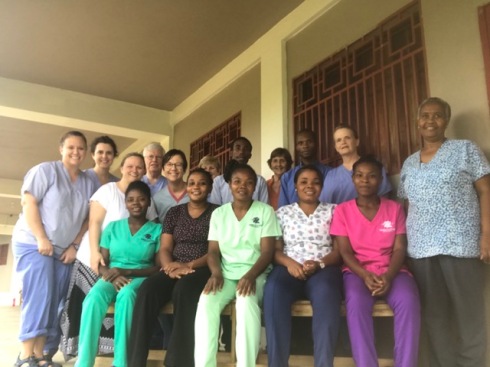 Sitting: Vetelie, Marie Esthere, Marie Vierge, Marie Laura, Fineaud
Sitting: Vetelie, Marie Esthere, Marie Vierge, Marie Laura, Fineaud
Standing: Jodi, Jamie, Tracy, Gil, Sandra, Kathy, Adrien, Katie, Junior, Becky, Cherlie
Dr. Gil English has become a regular part-time physician at our clinic with visits here three times a year. Not only does he do Pap smears on our patients, he follows up with all the abnormal results, doing colposcopy and LEEP procedures when necessary. In addition, he does general patient consultations and even gives some of his elderly patients reading glasses! He is definitely a one-stop shop!

Dr. Gil English helps a patient try on a pair of reading glasses.
Here’s the end result of his efforts:
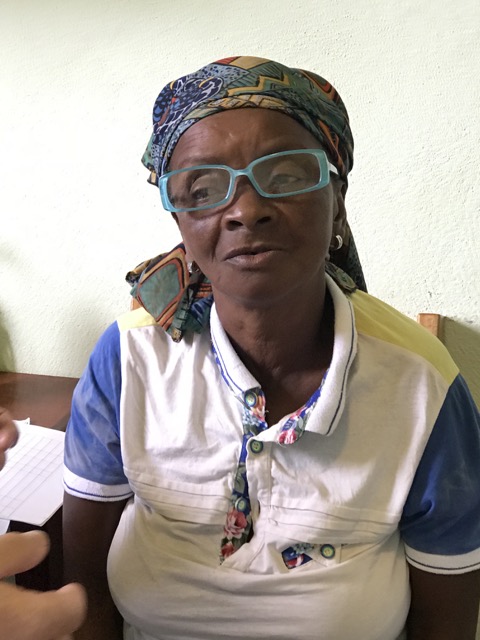
Happy patient with her new, snazzy glasses.
Kathy English did a wonderful job in getting everyone oriented prior to their trip and helped direct their tasks in the clinic each day. She spent her time assisting her husband in doing Pap smears, as well as distributing clothing and gifts to the clinic patients.
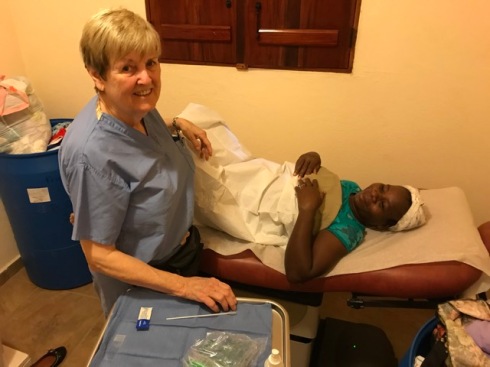
Kathy English prepares a patient for a Pap smear.
This was Tracy Barton-Opdahl’s third visit with us and she felt right at home! She helped the physicians, gave out gifts and became fast friends with everyone she met, including this man she met along the road outside the clinic:

Tracy befriending a man along the road outside the clinic.
Nurse practitioner Jamie Miller helped with patient consultations and Pap smears. Almost 300 patients were seen in the clinic in the four days the team was here.

Nurse practitioner Jamie Miller doing a patient consultation in the clinic.
Jodi Lienhard did both ultrasound exams and xrays for us. Our pregnant patients were thrilled to learn the sex of their unborn infant! This was Jodi’s second visit to us and she was a huge help to us in improving our patient services. We had scheduled dozens of patients in advance for ultrasounds and xrays and the results helped significantly with our patient care.

Jodi does an ultrasound on a pregnant patient.
It seemed to Cherlie and me during the week, that it must take a special person to be an elementary school teacher in the US. And, special is definitely the word we would use to describe teacher Sandra Dostal. Her energy and enthusiasm was infectious and her stories about her students back in the US kept us laughing all day (especially the one where a student thought she was too old to be making this trip to Haiti!). She helped out everywhere, making friends quickly and laughing her way through each day.

Sandra befriends a patient.

Sandra did sit down periodically, helping Adrien write receipts in the registration area.
We’ve never met Becky Borer’s 90 year old mother Lorraine, but we feel like we know her well. Each year she and a group of women friends in Atkinson, Nebraska make the most beautiful pillowcase dresses for us to give to our patients. In the pocket of each dress, Lorraine puts a plastic frog with a little note from her that tells the children about her and lets them know why she puts a frog in the pocket of their dress. The note says, “I’m sending you a frog. A frog means: Fully Rely On God.” That’s pretty special and the kids love the frogs!
Lorraine is unable to take such a long trip so Becky came to Haiti instead and we loved having her. Becky’s warm demeanor was a blessing to us and to our patients.

Becky sits with a new friend, one of our faithful patients.
Nick and Christian had their hands full during the week as they built and mounted 9 doors inside the residence building. They worked so quickly, we couldn’t believe all that they accomplished in such a short time. At home, both are teaching right now, Christian in a high school and Nick in a technical school. Nick has years of experience as a contractor and builder in addition to being a skilled carpenter. We felt blessed by their expertise and dedication.

Nick preparing wood with Viel and Lubin.
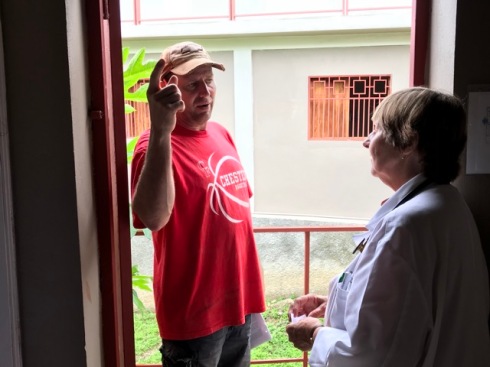
Nick discusses strategy with Dr. Wolf to be sure they’re both on the same page!

Nick and Christian stand in front of one of the doors they just built.
A few months ago, another Avera team gave us a gift of a hand-made quilt showing a map of the US and Canada. They then hung it up on a wall in the residence quarters where all of our visitors stay, with the idea that each team that comes to visit can sew a button on the quilt to show where they came from. Last week’s team sewed on their button and Tracy and Jodi show the location:

Tracy and Jodi point out the location of South Dakota where their team hails from on the quilt in the residence quarters.
We feel blessed to have had such a wonderful team helping us out this week and we’re grateful for the Lord’s watchful safe-keeping as the team travelled back and forth between the US and Jérémie. Kathy did a wonderful job of preparing them for every eventuality and organized their activities during the week so things ran smoothly. Thanks to everyone for your prayers and thanks to the Lord for safety.
– Dr. Katie Wolf
On February 7th, 2019 opposition parties in Haiti called for people to take to the streets to protest the present government of President Jovenel Moise. The underlying feeling was that this would be a day of protest and things would get back to normal quickly. But, as is often the case here, the demonstrations quickly turned violent. The following day, Friday, February 8th, Denver veterinarian Nancy Willerton, her husband Craig Mills, their twin adopted Haitian sons Zeb and Zadie, Emmy-award winning journalist Tamara Banks and her videographer Janine Trudell were scheduled to fly on a red-eye flight to Miami and on to PAP arriving Saturday morning, the 9th. We discussed the situation on Friday afternoon and decided to go ahead and have them fly to PAP, where they had reservations at a hotel near the airport. None of us were anticipating the violence that the next few days brought to the entire country of Haiti. They didn’t arrive until late Saturday afternoon, due to delays in their flight. I had already made several calls to the hotel to check on their arrival and to be sure the hotel van was going to pick them up at the airport. I didn’t want them to be left on their own! The anxiety, excitement and challenges had begun!
Prior to their arrival, I had planned a busy week for three groups within the group. Nancy was going to examine, vaccinate and put ear tags on all 208 goats in our new Goat Program. Craig and the nine-year old twins were going to help with the goats, visit local Haitian schools and explore the communities. And, Tamara and Janine were going to do interviews and videotape staff and patients in the clinic and people in the communities in order to produce some videos for us. Every day was planned to a T. Translators were lined up for all three groups. The residence was clean and ready to receive them. Menus were planned, including a Haitian meal at the home of one of our pastor friends whose community was involved in the goat program. The plans of men (and women) were not to be!
Things in PAP deteriorated rapidly over the weekend. I had intended to go to PAP with two vehicles to bring the group out here to Jérémie, but the road was blocked by barricades and violence in several towns along the way. So, I began trying to find charter airplane flights to bring them out. The first contact didn’t answer his texts or phone calls. In the meantime, the hotel where the group was staying didn’t have room to keep them another night. More phone calls to other guest houses close to the airport because driving to hotels further towards the middle of town was felt to be too dangerous. Finally, I found a guest house that was close and had room. More emails and phone calls making sure the group was picked up and made it safely to the new guest house. Communication was difficult because no calls were going through on the visitors’ cell phones, only email. Still no response from the pilot.
Sunday afternoon I was given a lead on another pilot who had a small plane that might be able to make two trips to Jérémie to get the group out here. “Maybe I can take them Monday”, the pilot said. But, Monday came and went without any confirmation. “I’ll try to bring them Tuesday”, he said. Meanwhile, on Monday the town of Jérémie erupted in violence. Tires burned in the streets, roads were cut off, windows of cars and businesses smashed. Our friends advised us not to try to get home Monday evening so Cherlie and I stayed up at the clinic. Tuesday was more of the same. Tuesday morning the group made their way to the airport to wait for the pilot. “I have to go to Cayes first,” the pilot said, “and then I’ll come back for your group.” Finally, we received an email from Nancy that said that they were coming in two planes, both at the same time. Good, that would make things easier. But, Jérémie was still unstable. We figured at least they could get to our house, which is on the outskirts of town on the way to the airport.
I got a call from our driver, Miller, who was supposed to be on his way to the airport to pick up the team. “There’s a roadblock and I can’t get past”, he said. “There are tree branches all across the road and large rocks.” I couldn’t believe it. Who would think that there would be problems that far outside of town? As we’re talking, the plane lands at the airport. “Did you tell them you need to get through to the airport?” I said, thinking how stupid that would sound to a bunch of militants. Like who cared if he got to the airport to pick up a bunch of visitors? Then, I thought, if the group is stranded at the airport and can’t get to our house, better they go back to PAP and go back home.” I was already resigned to the fact that our plans for this week weren’t to be. I quickly sent a text message to the pilot “Take them back! The road to the airport is blocked.” The pilot calls. “I can’t take them back with me and someone here says the group can stay at his guest house which is close to the airport,” he says. As I’m talking with the pilot, Miller pulls up at the airport in our jeep. He had paid the guys at the roadblock and they let him pass through. Easy as pie! I talk on the pilot’s phone to Nancy. “We’re fine,” she says. “Just wait,” I think to myself.
They got to our house safely and were able to relax, even without any running water, and enjoyed a supper made by Miller. Meanwhile, we were still stuck up at the clinic. The bridge leading into town was blocked by burning tires. We made plans to have the group leave Jérémie early the next morning, hoping that the roads would be cleared of debris later that evening. Gemi’s brother, Ginet, would do a dry run on his motorcycle and let Miller know what roads were blocked and which ones were open. Nancy and I emailed back and forth. They were fine.
We got up early Wednesday morning after a sleepless night. What would the day bring? We awaited word from Ginet. Miller was ready and the luggage was loaded on the roof of the jeep. The group had coffee and was eating breakfast. Finally, Gemi called. The roads were open and the bridge was clear. I called Miller and told him to follow Ginet through town and bring the group up to the clinic. Fingers were crossed and prayers went upward. After an agonizing 45 minutes, we got word that they were past the bridge and on their way up the mountain. Clear sailing now! What relief.
In the next three days, the team accomplished everything that needed to be done that week. The boys didn’t get to see a Haitian school in session but they made lots of friends among the Haitian children plus they did a great job helping their Mom with the goats. Tamara and Janine didn’t interview the patients I had planned for them but they found others to interview and they got video of everything they needed. The group didn’t get their Haitian meal on Tuesday as planned but they got it on Thursday. All the goats were examined, immunized, logged into the log sheets and tagged. And, we were able to get down to our own house each evening and bring food up for the group, who stayed at the clinic residence.

Nancy works on a goat with Zadie (L) and Zeb (R) behind her. Other Haitian boys play with a soccer ball the boys brought.

Tamara conducts an interview that Janine is videotaping while translator Reginal looks on.
The group blessed us in other ways as well. Tamara brought with her some small, plastic solar lamps as part of her “Be Brilliant” program. The boys brought soccer balls for the children in each of the communities they visited, as well as lots of lollipops to give out and small toy cars for my clinic patients.
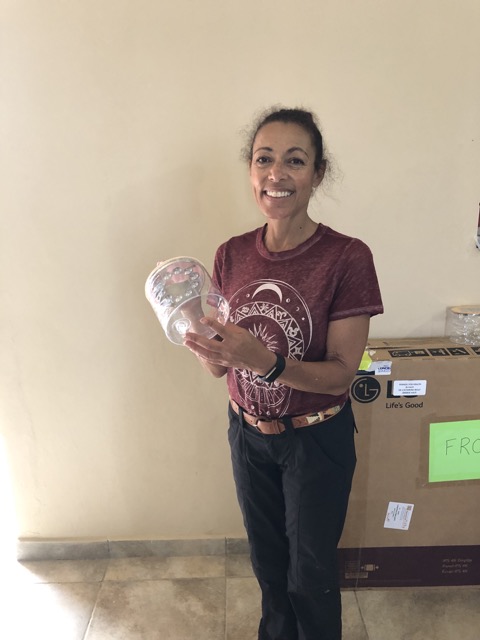
Tamara holds up one of her portable solar lights that she left for us to give to school children to use to study in the evenings and early mornings.

Zeb and Zadie brought down some beautiful new cars that I gave out to boys in the clinic like this one.
Through the whole week, we saw evidence of the grace of the Lord and the goodness of His people. From the pastor who offered to house the group at the airport to Ginet who acted as Miller’s scout, to the communities that welcomed the group with open arms and hearts, to neighbors who visited us and brought us food when we were stranded at the clinic, to friends in the US and patients at the clinic who prayed for us, we felt the Lord’s hand upon us and our visitors. But, the week wasn’t quite over.
We had made plans long before their visit for an MAF charter plane to come get them in Jérémie on Saturday, take them back to PAP where they would get their flight back to the US and home. I knew that the plane was undergoing routine maintenance that week and I also knew that things were very “hot” in PAP. So, I wasn’t surprised when I got an email on Wednesday stating that MAF wasn’t sure if the plane would be ready by Saturday for the flight. Their staff were unable to get to work in PAP due to the unrest, so the plane’s repairs were delayed. “OK,” I thought. “Here we go again. More uncertainty.” It’s become a way of life. Each day brought emails back and forth. Things were unstable. Mechanics couldn’t get to the airport. Things were more calm. Plane was being worked on. Finally, on Friday afternoon, MAF wrote and said that they were going to try to make the flight to Jérémie around noon on Saturday. The end was in sight.
Saturday, just before noon, we loaded the jeep and headed to the airport. Luggage was weighed, log sheet filled out, and, after an hour’s delay, the plane appeared in the sky above the trees. Praise the Lord! Soon the intrepid group was back in PAP and, after that, on their way to Miami and Denver. It was an incredible week with incredibly flexible, adaptable and unflappable people. You all were troopers! We give our thanks to the team and to those who stood in prayer behind them. Bless you all.
 Denver group on their last day in Haiti From left: Zadie, Craig, Zeb, Nancy, Janine, Tamara
Denver group on their last day in Haiti From left: Zadie, Craig, Zeb, Nancy, Janine, Tamara
As most of you who have been following us very long know, life here in Haiti can be difficult and challenging on a regular basis. Just over the past few days there has been unrest again in Port-au-Prince, making travel difficult and creating uncertainty regarding whether or not to have visitors come to work with us. Right now, we have a group of 7 waiting in Port-au-Prince at a hotel, unable to get out to Jérémie. The predictions that this unrest would be short-lived are proving themselves to be quite wrong, unfortunately. We appreciate your continued prayers for them.
In our daily lives, we often have difficulties as well, mostly related to ADLs, or activities of daily living. There are things that we take for granted in the United States such as 24/7 electricity, running, drinkable water and flushing toilets. In Haiti those things are a luxury. How well do we now know it!
For the past three months, Cherlie and I have not had running water at our house in Jérémie. This is because the transportation department has torn up the water pipes along the sides of the road outside our house in order to build drainage ditches and pave the road. It’s a huge government project that just started recently.

Part of a PVC pip lying on the road after being dug up by construction equipment.
 Drainage ditch being built along one side of the road going into town.
Drainage ditch being built along one side of the road going into town.

Drainage ditches on both sides of the road.
So, why do we not have water and how does the water system work around here?
Well, our house is situated on the main road leading from the town of Jérémie to the airport. Along the road, buried not very deeply, are pipes that bring water from a huge reservoir several miles from us, into town. These pipes supply the numerous public fountains along the road, where people can get water on a near-constant basis without paying for it (it usually runs all the time during the day).
Other people, like us, pay a monthly fee to the government and we have a pipe that comes in off the road onto our property. Even so, we have never received water all the time, so we have plastic storage tanks, 200 gallon and 400 gallon, on our roof to conserve water. Normally, when the water is turned on for us, coming in from the road, there is enough pressure in the pipes to push it all the way up onto the roof and into the storage tanks. When the tanks are full, the water turns off and goes instead into a large cistern under Cherlie’s closet. This is basically a big room built into the lower floor of the house and conserves water for the times when we don’t get it coming in through the pipes. We have a water pump in the cistern so we can pump water from the cistern up to the roof if needed. Water then feeds by gravity from the roof tanks down into the bedrooms, bathrooms and kitchen for our daily use. When it’s just the two of us here, the roof tanks can last for 2 – 3 weeks with conservative water use. And, by pumping water from the cistern to the roof, our water supply can last for a couple of months (as long as we don’t do laundry with it).
Well, the cistern is now empty. So, for the past month or two, we have been bringing buckets and 5 gallon jugs of water from the clinic (where we have a very good well and plenty of water) down for our use at home. We’re bathing from water in buckets (which is definitely a technique to be mastered!) and using buckets of water to flush the toilets. Needless to say, our upper body strength is being improved with all the buckets we carry to our bathrooms every day!
They say that necessity is the mother of invention and, in our case, that’s proving to be true. The other day I went down to the government water office and asked them how long we would be without water. “Oh, it’s going to be a long time,” the guy in the office said. “It’s not just a matter of repairing the pipes, all new pipes need to be laid,” he explained. Of course, the problem was not their fault, it was the fault of the transportation department (all part of the same government but so what?). So, we realized that we’re in this for the long haul and if we want to have water for our visitors and if we want to take showers again instead of bucket baths, we need to do something about it.
Let me digress by saying that we did try to do something about our water situation two years ago because we were suffering from vandalism of our pipes. We had another mission organization come dig a well in our yard but lost our $5000 investment when they struck salty water!
But, our present situation is a real dilemma that won’t be resolved soon. So, we decided to set up a rainwater collection system using drainage pipes that come off our roof and connecting them to the cistern under Cherlie’s closet. Once there’s rain water in the cistern, we can pump it up to the roof and have running water again!

PVC pipe coming from the roof and going into the cistern to collect rain water.
Of course, with our new system, we need rain. So, let the rain dances begin!
We’ve written a lot of blogs about medical teams that come to visit us from Avera Health System in Sioux Falls, SD, but that’s because they send a team to visit us three times each year! Last week, we had a visit from an Avera team of twelve and it was another wonderful week of hard work, enthusiasm, expertise, fun and fellowship. The leader of the team, as always, was nurse Kathy English and she did another superb job of organizing the logistics. She had everyone prepared for his/her tasks, giving the seven nurses on the team assignments to follow throughout the course of each day. It made things run very smoothly, helping us not only in the clinic but also in the pharmacy and lab as well.
The team consisted of Dr. Gil English, Dr. Scott Peterson, farmer Jamie Voneye, ultrasound technician Joan Eischen, rancher/handyman Jerome Malsom and his wife, nurse Gerri. Other nurses included Stephanie Brandt, Allison Pederson, Sara Romeo, Ashley Walter and Shauni Dietrich.

Dr. Gil English had a very productive week as he did Pap smears on new patients and provided follow up for previous patients with abnormal results. It is such a blessing to us to have his expertise available to our patients. Rather than just diagnose possible cervical cancer, Dr. English is able to provide definitive treatment to remove abnormal areas and he’s truly saving lives.

Dr. Wolf consults with Dr. English regarding one of her patients
Family physician Dr. Scott Peterson was with us again, one of multiple visits for him. Scott saw patients of all ages, did Pap smears and helped Dr. Wolf do some gastroscopy exams as well.

Dr. Scott looks on as Dr. Wolf performs a gastroscopy.

Dr. Scott examines a patient in the clinic.
The clinic was crowded all week because people knew we had visitors to help us out. Many women came because they wanted to get a Pap smear. In the four days the Avera team was here we saw 398 patients, close to one hundred each day!

The front porch of the clinic was overflowing each day and there were 50-60 more on the benches each afternoon, preparing to spend the night in order to be seen the following day.
We felt especially blessed to have Joan with us, since she was a radiology technician before she became an ultrasound technician. She did both ultrasounds and x-rays for our patients and we made many very important diagnoses thanks to her expertise. In addition, she organized the x-ray room, setting up shelves to hold important supplies and arranging the equipment in a way that will be easy for us to use.

Joan does an ultrasound on one of our little patients.
The nurses were fantastic, helping to start IV’s and sedate patients for gastroscopies, doing vital signs, assisting the physicians, doing rapid lab tests and helping out in the pharmacy.

Stephanie takes vital signs on a patient.

Nurses Ally, Sara, and Kathy help Cherlie and pharmacy tech Marie Vierge in the pharmacy.

Shauni feeds a malnourished, hungry infant.

Kathy helps out by writing receipts in the pharmacy.

Geri and Stephanie do some dental hygiene teaching for patients waiting to be seen in the clinic.
Jerome kept busy most of the week driving the skid steer (he was the one who found it and arranged for its purchase in the US). He cut down the ridge along the side of the road leading up to the clinic to prepare it for building a retaining wall along the edge of our property.

Jerome hauls rocks from the side of the road with the skid steer as Viel helps.

Side of the road leading up to the clinic, trimmed back by Jerome with the backhoe.
South Dakota farmer Jamie came down with the team to determine the potential for some future agricultural programs. We were thrilled to have Jamie with us and he helped out in many ways throughout the week. Jamie helped Jerome with the skid steer, organized the tools in the workshop, helped fix some equipment and even helped to count meds in the pharmacy! Jamie also planted a couple of “experimental” gardens at the clinic…“experimental” meaning they may or may or may not grow!

Jamie shows Gemi and Cherlie his new garden!
Jamie also went out with some of the nurses to two communities to help with health teaching and blood pressure checks. Along the way, he learned about Haitian farming from Gemi and the translator and visited with farmers.

The hike to Charlotte involved climbing a steep mountain but the team was up for the challenge!
The community of Charlette welcomed the team warmly, even providing them with breakfast of fresh eggs and milk. Their local church doubles as the school. The team did some health teaching for children and adults, after which they checked blood pressures, referring those with high readings to the clinic for follow up.
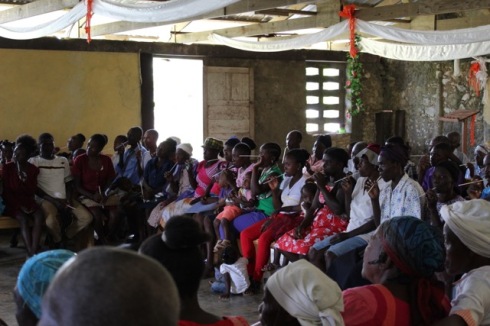
Members of Charlotte participate in a hypertension teaching session.

Avera nurses check blood pressures for people in Charlette.

Ashley makes a new friend!
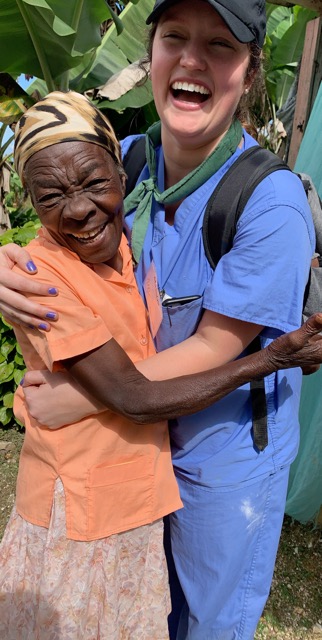
Ally gets a warm embrace!
Jamie had so much fun playing with the children in the schools where the health teaching was being done that a mother put her infant daughter in his arms! Jamie and his wife have 5 boys so holding a little girl made him all smiles.
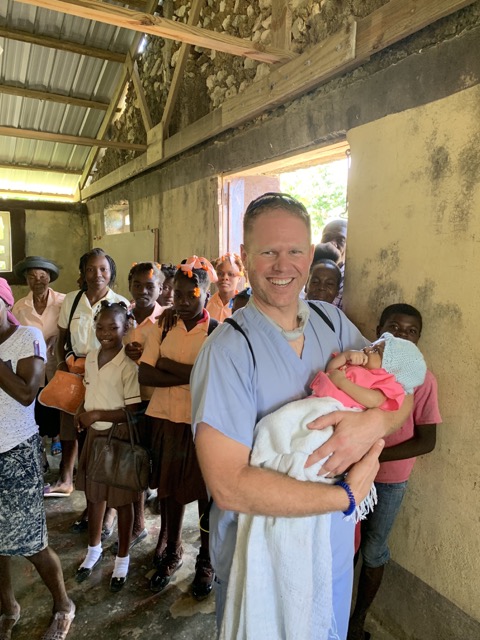
Jamie is loving holding this little girl!
Cherlie went with another group of nurses and Dr. Scott to the village of Labastille to do some health teaching and check blood pressures.

Sara and Cherlie and the team on their way to Labastille.

Health teaching in Labastille school.
One of the highlights of this visit was receiving a gift that was made by some friends of Jerome and Gerri Malsom – a hand-made quilt of the US and Canada with each state identified so that future visitors can pin a button on their home location. Over the years, we will be able to get an idea of how far our visitors are traveling to come work with us.

Jerome, Dr. Wolf, and Gerri hold up the handmade quilt that was brought down as a gift to us. It is now hanging on a wall in the clinic residence.
Much thanks to the Avera team and their generous friends and supporters! It was a wonderful week for the clinic, our staff and especially our patients. Blessings to you!
Twas the day before Christmas and the good doctor and nurse played Santa on their way down the mountain after clinic. Last year, we had some wonderful visitors here in December who made up gift bags of clothing and toys that we distributed to about 100 children who lived in homes along the road we take back and forth to clinic. Well, this year we didn’t have Santa’s elves to help us out, so Cherlieand I were left to our own devices, short on time and lacking in creativity. There were some large stuffed animals that had been sent down to us by some generous partners, sitting in bags in our clinic conference room. They actually were a little irritating to me because they were big and took up a lot of room and we couldn’t really give them out to our clinic patients without causing some jealousy (we usually give out small beanies or small toy cars to our young patients, not big animals like these). So, for months the animals have been waiting patiently for a chance to bless someone’s little life.
Well, that chance came today when I received a visit from one of my favorite little 7-year old boys. He’s been coming to the clinic since he was an infant and waves to us on his way to school every day. I was smitten with him years ago. Today he came in with his mother for a consultation and I realized I had to come up with a wonderful Christmas gift for him since it was the day before Christmas! What a dilemma! I couldn’t just run out to the local Walmart, so I visited the conference room instead. There, I saw the stuffed animals, sitting in plastic bags, bursting with pride at the thought of going home with one of my favorite boys! And, go home they did, six of them actually, one for each of the children in the home.
 Emmanuel holding his new stuffed animal
Emmanuel holding his new stuffed animal
Well, now that the idea was in my head, all the children who came to clinic today received a large stuffed animal.
 Another young patient with her new stuffed friend.
Another young patient with her new stuffed friend.
At the end of the day, we filled the car with the rest of the stuffed animals and gave them out to our other little friends along the road down from the clinic. They were thrilled with the gifts and I was glad to have the opportunity of giving them away for a good cause.
 Cousins from three families are all smiles!
Cousins from three families are all smiles!
 Another little friend of ours with a stuffed animal almost as tall as she is!
Another little friend of ours with a stuffed animal almost as tall as she is!
So, the moral of our story today is twofold: what may be an irritation to us can turn into a wonderful blessing and eventually everything that comes to us to be given away is done so, in the right context and through the right relationships. Thanks to our partners for making gifts possible.
Cherlie and I and our staff wish everyone a very Merry Christmas!!!
Last April, at our annual fundraising banquet in Milwaukee, we announced the start of a new Goat Program. The program is designed to help rural families generate income to support themselves and their children. The response to our request for funding was overwhelming! Everyone wanted to buy a goat or two or three! As a result, we quickly began making plans to initiate the program in four communities near our outpatient clinic in Gatineau. The communities we chose were Duchene, Gatineau, Nouvelette and Fraise, the latter two being communities where we have our Community Promoters and Water and Sanitation program. All four are communities in which we’ve built latrines. Each of the four communities is well-organized and has leadership within, making them ideal places to begin this new and exciting Goat Program!
The first step was to have the communities set up a committee that will provide oversight of the program. The committees then chose two people to take responsibility as supervisors of the program, keeping all of the statistics and managing the day-to-day operations of the program. The supervisors will report to Gemi and Viel, our Community Coordinators, and then to Cherlie and me. Each of the four committees chose 25 families to receive two female goats each. They also chose two other families to care for the two bucks that will be used for breeding.
In August, in collaboration with our partners from Mt. Horeb United Methodist Church in Columbia, South Carolina, we held training sessions for the goat recipient families in each of the communities. We taught them about caring for the goats and trained them on Biblically-based business principles. After this, the families began to get ready to receive the goats, building pens and shelters for the two bucks that will be used for breeding, and preparing their yards to receive the female goats.
When Cherlie and I got back from our trip to the U.S. in November, we met with Gemi and Viel to plan our goat purchasing strategy. A couple of weeks ago, we put that strategy into operation! Each day of the week, a different community in the area holds a market where agricultural products and animals, such as sheep, goats and pigs, are sold. Gemi and Viel went with our veterinary technician, Bruni Chevalier, and supervisors from one of the four communities to a different market each day of the week, purchasing goats for their specific community that day. On Tuesdays, there is a market in Leon and Nouvelette is the community that is closest to Leon. So, the “team” went from Nouvelette to Leon to purchase female goats for families in Leon.
 Team members lead goats home from the market in Leon to Nouvelette
Team members lead goats home from the market in Leon to Nouvelette
The goats were led home by the team members, who had to walk up and down the mountain paths and sometimes cross streams and creeks. Some of the goats didn’t seem too excited about jumping across the water!
 You want me to cross what? To go where?
You want me to cross what? To go where?
Wednesday is market day in Marfranc, which is closest to Fraise, so on Wednesday a team went from Fraise to the market in Marfranc. Marfranc is a large market and the team was able to purchase about 25 goats in one day!
 Goats all standing around in Marfranc market
Goats all standing around in Marfranc market
 Beautiful female goats!
Beautiful female goats!
The purchase of each goat has to be registered by an official who sits in the market area. Each goat is given a registration number and paperwork to prove ownership. This paperwork allows the new owner to bring the goat to his/her own community. Theft of animals is common here, so the paperwork is necessary to prove that the new owner legally purchased the animal.
 The registration official at the Marfranc market registers all the goats.
The registration official at the Marfranc market registers all the goats.
Once the goats are purchased, they are placed with their new owners who begin to care for them. Thus far, almost 70 goats have been purchased by Gemi and his team. Medications for worms and parasites were purchased also and are being given to the new goats by Bruni, our veterinary technician. We want the females to be in top shape when breeding begins early next year.
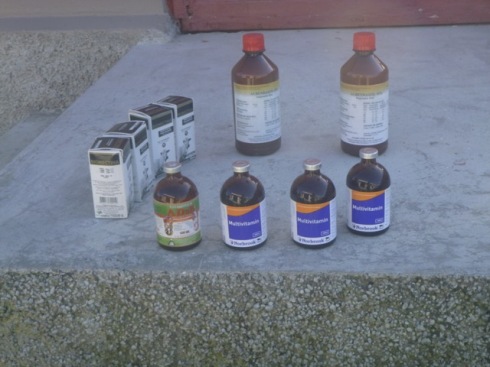 Medications that were purchased for the newly acquired goats.
Medications that were purchased for the newly acquired goats.
We want to thank all of our donors and supporters for this wonderful start to our new Goat Program! We especially thank Wade McGuinn and our partners from Mt. Horeb United Methodist Church as well as Dr. Nancy Willerton from Denver, Colorado, for their expertise and assistance with this program. If you haven’t already, you can still buy a goat or two or three! Each female costs about $50 and the breeding males cost $200. Pray with us for continued success in the program.
Cherlie and I have been in the U.S. for the past couple of weeks. At the end of October, we were privileged to be a part of a Haiti Appreciation Luncheon at my home church, Kingston Presbyterian Church (KPC) in NJ. We had a great time catching up with lots of friends and church members from KPC as well as other churches in the area. We are so grateful for their faithful support of our ministry in Haiti. Presbyterian Women from the New Brunswick Presbytery provided us with a wonderful lunch, replete with homemade desserts! Thanks to Helen Burd, who rallied the Presbyterian Women troops, and Pastor Sharyl Dixon who coordinated all the Kingston Presbyterian Church faithful.
 Luncheon attendees enjoying the food and fellowship as well as an update from Dr. Wolf!
Luncheon attendees enjoying the food and fellowship as well as an update from Dr. Wolf!
 One of the highlights of the luncheon was the sale of Haitian crafts, just in time for the holidays
One of the highlights of the luncheon was the sale of Haitian crafts, just in time for the holidays
Some of the crafts that were sold at the luncheon were handmade items sewn and embroidered by students and graduates of Centre Lumiere, a vocational school in Cayes, Haiti, run by missionaries who we used to work with. Their aprons, purses, accessory bags, microwave pads, tea towels and pot holders were beautiful and almost sold out. Centre Lumiere items will soon be available for sale on the Friends for Health in Haiti website. Stay tuned!
 Handmade mother/daughter aprons and other items made by students and graduates of Centre Lumiere in Cayes, Haiti
Handmade mother/daughter aprons and other items made by students and graduates of Centre Lumiere in Cayes, Haiti
The day after the luncheon, I attended church at Kingston Presbyterian Church, my home church. In Sunday School, they asked me to speak to the youth about my early years growing up in the church and the influence it had on my decision to be a missionary. After that, everyone joined together in organizing a craft project to be used by our patients as they wait for their turn to be seen in clinic. It was intergenerational Sunday and young and old joined together to count plastic beads and cut plastic cord to put in a bag to be used to make a lovely necklace. When we get back to Haiti, we’ll distribute the materials to patients who are staying overnight on the clinic porch and will see what creations they show us in the morning!
 Young and old(er) making up plastic bags with beads and cords for necklaces.
Young and old(er) making up plastic bags with beads and cords for necklaces.
Two of the VIPs in Sunday School that day were my sisters, Laura Bedient, who is also a member at the church and Janice McMullin, who came up from her home in Virginia for the occasion.
 Dr. Wolf’s sisters Laura Bedient and Janice McMullin in Sunday School
Dr. Wolf’s sisters Laura Bedient and Janice McMullin in Sunday School
After our wonderful time in NJ, Cherlie and I then flew out to Milwaukee. There we had a productive FHH board meeting, shared a meal with our logistics coordinators Ray and Donna Moon, met with prayer partners at Eastbrook Church and took care of doctor and dentist appointments. We spent a wonderful morning in our new FHH office with Development Director Natasha Irish and Administrative Assistant Susan Baumgartner. Although lacking office furniture, the office is warm and welcoming and the productivity of Natasha and Susan is quite amazing! We’re thrilled to have them both on board.
Last Wednesday, seven of us took a road trip to Louisville, KY to attend the annual Global Health Conference co-sponsored by Christian Medical and Dental Association. One of the reasons we went to the conference this year was to promote the fifth edition of a book I co-authored, which now has a new title “Handbook of Medicine – a manual for practitioners in low-resource settings”. Our team consisted of Cherlie and me, logistics coordinators Ray and Donna Moon, Yvonne Ducharme, Jeanette Schweitzer and Development Director Natasha Irish.
 The new fifth edition of a book co-authored by Dr. Wolf.
The new fifth edition of a book co-authored by Dr. Wolf.
On our way, Ray and Donna drove a rental truck to Bluffton, IN, filled with drums of medical supplies, pharmaceuticals, toys and clothing for our patients in Haiti. We dropped off the items at the warehouse of Harvest Call, the mission branch of Apostolic Christian Church, who allow us to ship things on their containers to Haiti. Then, we continued on our way to the missions conference.
Unloading the truck was a team effort!
While I was at the Christian Medical and Dental Association booth discussing the new book, the rest of the team was networking with other organizations, attending the seminars and making friends with medical personnel who might some day be able to help us out in Haiti. Thank you, team, for all your hard work during the weekend! If you want a copy of the book, go to the CMDA website (http://www.cmda.org).
Not everyone who visited the clinic with the Avera team provided medical care. One of our volunteers fulfilled a very important role during his time at the clinic: handyman! Dan Irvine was gracious enough to strap on his tool belt and tackle some of the projects on Dr. Wolf’s to-do list. Most of his tasks involved hanging or assembling. Dan hung clocks, otoscopes, and hand sanitizer dispensers on the clinic walls. He hung ceiling fans throughout the clinic buildings. He assembled a television cart and mounted a TV to be used for educational videos. Dan even spruced up Dr. Wolf’s and Cherlie’s home with some new handmade curtains sent all the way from South Dakota.


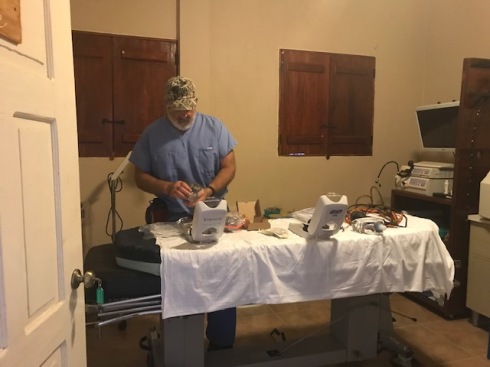
The highlight of Dan’s week was putting our new skid steer to use! Dan hauled some rocks leftover from construction on the road outside of the clinic to the creek underneath the bridge. Dan also used the skid steer to help spread some dirt outside of the residence building for planting. Miller gave him a hand, delivering loads of dirt in the dump truck. The kids waiting at the clinic enjoyed watching the action!



We are lucky to have a pharmacy at our clinic from which our patients can receive their medications from.



We purchase a lot of our medications directly in Haiti; however, some vitamins and other medicines cannot be found there or are temporarily unavailable. When visiting teams come to Haiti, they bring a supply of what we need. The Avera team came with a fresh supply of vitamins and other valuable medications for our pharmacy.

One of our volunteers, Sharon (a respiratory therapist with Avera), made the pharmacy her project for the week. In addition to counting and restocking meds, she took on the task of organizing and labeling all of the medication shelves in the store room. Together, Sharon and Bevin (one of the Avera nurses) sorted all of the medications alphabetically and re-labeled the shelves, making it easier to find medication in an efficient and timely manner.

Sharon and Bevin sorting medications.


We are thankful for all of the volunteers who visit our clinic and enthusiastically tackle any project we throw their way. Thanks for helping make our pharmacy run a little smoother, Sharon and Bevin!



